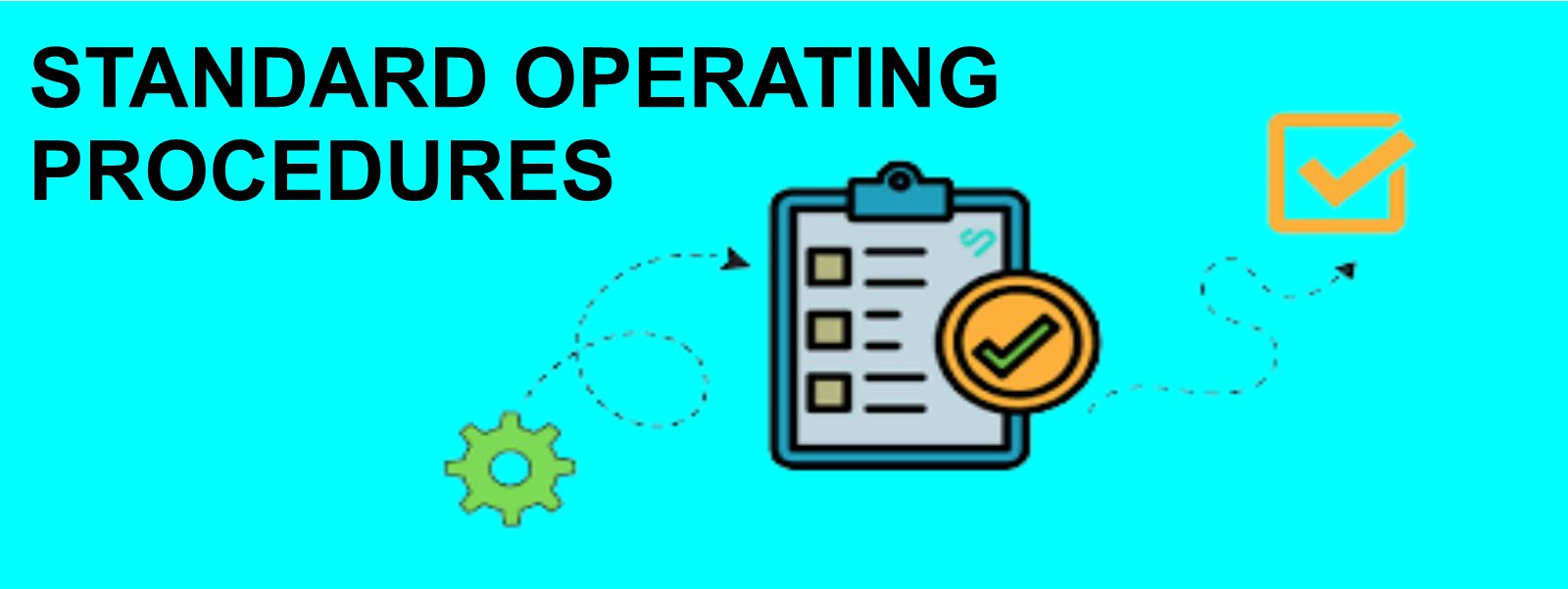
STANDARD OPERATING PROCEDURES (SOP)
A Standard Operating Procedure (SOP) is a set of written instructions that document a routine or repetitive activity followed by an organization. The development and use of SOPs are an integral part of a successful quality system as it provides individuals with the information to perform a job properly, and helps consistency in the quality and integrity of a product or end-result.
The SOPs detail the regularly recurring work processes that are to be conducted or followed within an organization. They document the way activities are to be performed to facilitate consistent conformance to technical and quality system requirements and to support data quality.
They may describe, for example, fundamental programmatic actions and technical actions such as analytical processes, and processes for maintaining, calibrating, and using equipment.
SOPs are intended to be specific to the organization or facility whose activities are described and assist that organization to maintain their quality control and quality assurance processes and ensure compliance with governmental regulations.
The current copies of the SOPs also need to be readily accessible for reference in the work areas of those individuals actually performing the activity, either in hard copy or electronic format, otherwise SOPs serve little purpose.
SOPs should be written in a concise, step-by-step, easy-to-read format. The information presented should be unambiguous and not overly complicated. The active voice and present verb tense should be used.. The document should not be wordy, redundant, or overly lengthy.
Information should be conveyed clearly and explicitly to remove any doubt as to what is required. Also, use a flow chart to illustrate the process being described. In addition, follow the style guide used by your organization, e.g., font size and margins.
There must be a procedure in place for determining what procedures or processes need to be documented. Those SOPs should then be written by individuals knowledgeable with the activity and the organization’s internal structure.
These individuals are essentially subject-matter experts who actually perform the work or use the process. A team approach can be followed, especially for multi-tasked processes where the experiences of a number of individuals are critical.
SOPs should be written with sufficient detail so that someone with limited experience with or knowledge of the procedure, but with a basic understanding, can successfully reproduce the procedure when unsupervised. The experience requirement for performing an activity should be noted in the section on personnel qualifications.
SOP GENERAL FORMAT
SOPs should be organized to ensure ease and efficiency in use and to be specific to the organization which develops it. There is no one “correct” format; and internal formatting will vary with each organization and with the type of SOP being written. Where possible break the information into a series of logical steps to avoid a long list.
The level of detail provided in the SOP may differ based on, e.g., whether the process is critical, the frequency of that procedure being followed, the number of people who will use the SOP, and where training is not routinely available. A generalized format is discussed next.
Title Page
The first page or cover page of each SOP should contain the following information: a title that clearly identifies the activity or procedure, an SOP identification (ID) number, date of issue and/or revision, the name of the applicable agency, division, and/or branch to which this SOP applies, and the signatures and signature dates of those individuals who prepared and approved the SOP. Electronic signatures are acceptable for SOPs maintained on a computerized database.
Table of Contents
A table of contents should be there for quick reference, if the SOP is long, for locating information and to denote changes or revisions made only to certain sections of an SOP.
Text
Well-written SOPs should describe the purpose of the work or process, including any regulatory information or standards that are appropriate to the SOP process, and the scope to indicate what is covered.
Define any specialized or unusual terms either in a separate definition section or in the appropriate discussion section. The sequential procedures to be followed, divided into significant sections; e.g., possible interferences, equipment needed, personnel qualifications, and safety considerations (preferably listed in bold to capture the attention of the user)should be clear.
s noted above, SOPs should be clearly worded so as to be readily understandable by a person knowledgeable with the general concept of the procedure, and the procedures should be written in a format that clearly describes the steps in order.
SOP Review and Approval
SOPs should be reviewed (that is, validated) by one or more individuals with appropriate training and experience with the process. It is especially helpful if draft SOPs are actually tested by individuals other than the original writer before the SOPs are finalized.
The finalized SOPs should be approved as described in the organization’s Quality Management Plan or its own SOP for preparation of SOPs. Generally the immediate supervisor, such as a section or branch chief, and the organization’s quality assurance officer review and approve each SOP. Signature approval indicates that an SOP has been both reviewed and approved by management.
Frequency of Revisions and Reviews
Whenever procedures are changed, SOPs should be updated and re-approved. If desired, modify only the pertinent section of an SOP and indicate the change date/revision number for that section in the Table of Contents and the document control notation.
SOPs should be also systematically reviewed on a periodic basis, e.g. every 06 months, to ensure that the procedures remain current and appropriate, or to determine whether the SOPs are even needed. The review date should be added to each SOP that has been reviewed. If an SOP describes a process that is no longer followed, it should be withdrawn from the current file and archived



